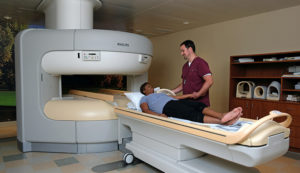
Back and Neck Pain Caused by the Spine
Did you know that spinal pain (back and neck pain) is the most common cause of disability worldwide and the second most common reason people go see a doctor? Most cases of back pain improve within weeks. Back pain can be caused by spinal abnormalities, injuries, arthritis and diseases that destroy the spine such as infection and cancers. However there are many other causes of back pain that has nothing to do with spine and discs such as kidney stones, gallbladder disease, pancreatitis, and abdominal aneurysm.
If you suspect your back pain or neck pain is caused by spinal issues such as a herniated disc, degenerative disc disease, or spinal stenosis, you should talk to a doctor to determine the cause. The first step will be analyzing all the symptoms of your back pain, and if there are any other associated symptoms you may have as well. An MRI focused on your spine can show you exactly what’s going on with your spine, and spinal discs to see if they are healthy or there is a problem causing pain for you.
MRI to Determine Back Pain Treatment
An MRI can also help determine whether or not pain treatment is the right path, or if spinal surgery should be a consideration. There are many types of spinal surgeries for treating the many spinal dysfunctions, such as laser spine surgery, spinal fusion, and laminectomy. Usually the goal of spinal surgery is to relieve pressure on your spinal cord nerves, which can become pinched and cause you that back or neck pain and tingling / numbness. In severe cases it can even cause weakness in the legs, making it difficult to walk.
Spinal Stenosis Pain
Spine pain can be caused by stenosis, which is a narrowing of the spaces within your spine, which in turn puts pressure on nerves going through these spaces. Typically this will occur more in the lower back and neck area of the spine, so if you have lower back pain or neck pain it could be due spinal stenosis. You may experience pain, tingling, numbness and muscle weakness and these symptoms can worsen over time. If the stenosis is effecting your neck it’s called cervical stenosis, if it’s causing pain in the lower back it’s called lumbar stenosis.
Spinal Stenosis Pain Management
Managing pain resulting from spinal stenosis is an important step in treatment. The pain management plan will change based on the exact cause. One of the causes of spinal stenosis is an overgrowth of bone, or a bone spur, caused by osteoarthritis and the degeneration of spinal bones. Another common cause are herniated discs, which is the bulging of a spinal disc to the point that it presses on nearby spinal nerves, causing pain. Spinal injures from physical trauma like a car accident can cause dislocations or fractures on your vertebrae and they may press on the spinal cord. There are a few treatment options for spinal stenosis pain such as laser spine surgery, an epidural steroid injection, endoscopic discectomy, and more. You’ll have to talk to your doctor to figure out what plan is going to work best for you.
What Causes Spinal Pain?
There can be many causes of spinal pain and back pain. Some of the most common include a herniated disc, muscle or ligament strain, sciatica, degenerative disc disease, and osteoporosis. Many of the risk factors for back or neck pain are age, lack of exercise of the surrounding muscles, excess weight, disease, improper lifting, and smoking. To prevent spine pain or future back pain you can do regular low impact exercise that don’t strain the back. Increasing the muscles in the back is pivotal. Maintaining a healthy weight is also important, so there is less pressure on parts of your spine. Avoiding slouching, and making sure you have a good ergonomic chair while sitting for a long time also helps prevent back pain.
Spinal Tumor Symptoms Back Pain
Sometimes spinal tumors have no symptoms, but eventually they lead to back pain and possibly other neurological deficits like numbness or weakness. The symptoms will vary based on where the tumor is located and whether or not it’s cancerous. The way a tumor can cause pain is by damaging healthy tissues like nearby vertebrae, or pressing on nearby nerves. Most spinal tumors effect the upper or middle back, rather than the lower back or neck pain, so you can somewhat guess what the cause of back pain is based on the location.
The pain experienced may feel like a deep ache or discomfort in the back, rather than surface pain. The pain could be in one region only, or radiate to the chest, abdomen, legs or arms. The pain doesn’t go away with rest or limiting of activity and possibly intensify at night, and can become worse if touched or compressed such as during physical activity. It’s also possible that it can be located in multiple levels of the spine.


